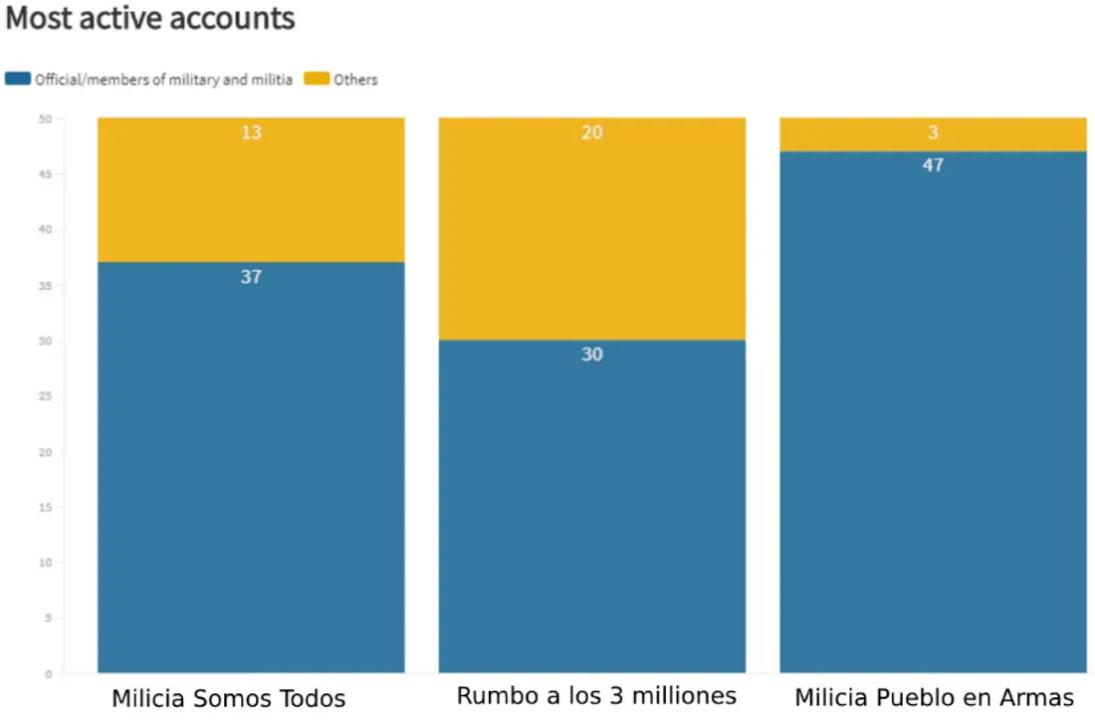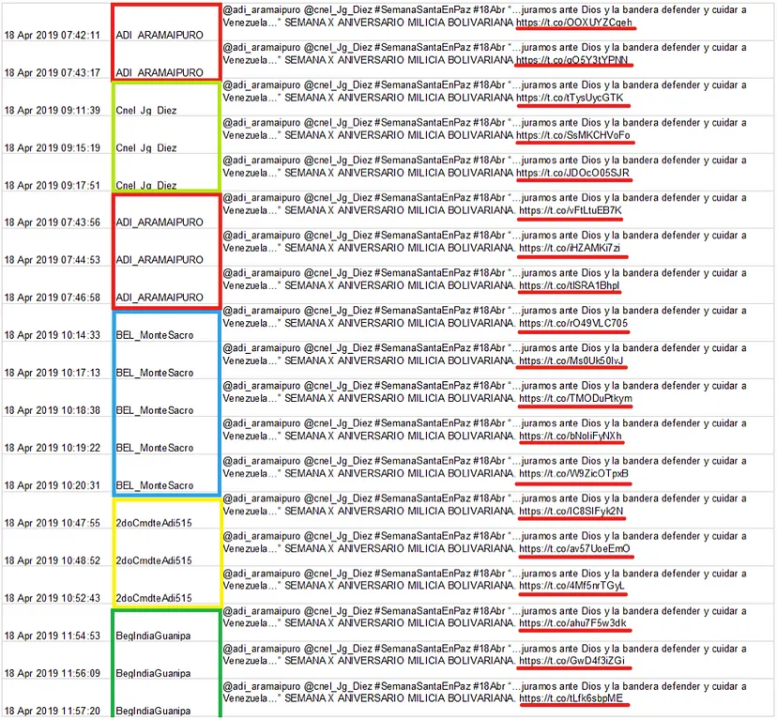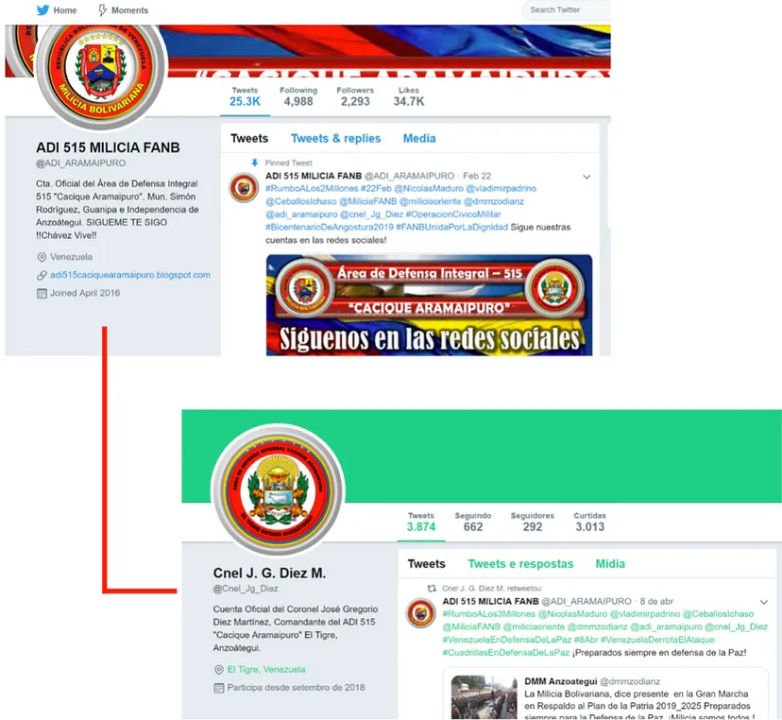Civilian Militias in Venezuela Coordinate on Twitter
Accounts affiliated with the Maduro regime posted repeated messages in narrow timeframes in attempt to manipulate Twitter traffic
Civilian Militias in Venezuela Coordinate on Twitter

BANNER: (Source: @luizabandeira/DFRLab via PrensaPresidencial and @ADI_ARAMAIPURO/archive)
Venezuelan civilian militias used institutional accounts to manipulate Twitter traffic in an effort to make hashtags trend in the country over a period of three weeks. These accounts repeatedly posted the same content within short intervals, using the same pro-Maduro hashtags.
The operation may have violated Twitter’s automation rule by, in particular, posting “duplicative or substantially similar Tweets on one account or over multiple accounts you operate.” Twitter suspended some of the accounts that participated in the operation during the course of the DFRLab’s investigation.
The attempt to manipulate Twitter traffic happened as the leader of the country, Nicolas Maduro, who has led Venezuela since the passing of Hugo Chavez in 2013, called for a million more Venezuelans to join the militia before the end of the year. The militias are formed by volunteers and are considered by law a complement to the country’s Armed Forces. Maduro’s statement came as opposition leader Juan Guaidó, who is recognized by more than 50 countries as interim president, tried to convince the military forces to abandon Maduro and support him. On April 30, Guaidó and supporters in the Venezuelan military declared the beginning of the “final phase” to remove Maduro.
Twitter has been one of the most important battlegrounds in Venezuela for years. The government started a sophisticated operation to control this space as early as 2009, with the use of trolls, bots, and intense tweeting coming from government actors. There are also extensive reports of inauthentic behavior coming from the opposition.
Militia Hashtags
The DFRLab analyzed three different hashtags that were used by the Venezuelan militia in April.
The first hashtag, #somostodosmilicia (“We are all militia”), reached the trending topics in the country on April 13, according to TrendoGate, a website that monitors hashtags in different countries. The hashtag was created to mark the anniversary of the creation of the Bolivarian Militia of Venezuela, set up by late Hugo Chávez in 2008. The militias and the regime used the hashtag to mark the anniversary and to convey that both the military and the civil population should support Maduro’s regime. This hashtag was mentioned 4,001 times between April 12 and 14.
The second hashtag, #rumboalos3milliones, is related to Maduro’s call to increase the number of militia members. According to Maduro, there were more than 2 million volunteers in the militia, a number since questioned by specialists. #Rumboalos3milliones was used 4,163 times between April 7 and 23.
Finally, #miliciapuebloenarmas, the third hashtag, was a reference to the idea of the military-civic union represented by the militias. Volunteers from civil society received military training, and Maduro repeated more than once that his intention was to give each member a rifle. The hashtag was used 1,528 times between April 10 and 16.
Boosting a Hashtag
All the hashtags show signs of traffic manipulation, as per an analysis made following the CTM (Coefficient of Traffic Manipulation) method. This measure, first developed by the DFRLab’s Ben Nimmo for the Oxford Computational Propaganda Project, is an early-warning system for traffic manipulation on Twitter but does not measure the effectiveness of a campaign. It is a relative, rather than absolute, indicator of manipulation, which means it should be used alongside other analysis.
Twitter traffic manipulation, as defined in the Oxford report, is “an attempt by a small group of users to generate a large flow of Twitter traffic, disproportionate to the number of users involved.” The CTM considers three factors as indicators of manipulation: the average number of tweets per user, the percentage of retweets, and the percentage of traffic generated by the most active 50 accounts. All three hashtags promoted by the Venezuelan military scored significantly higher than 12, which is the threshold at which the traffic under analysis can start to be considered suspicious and as a sign of inauthentic manipulation.

In all cases, a small group of accounts acted to create the impression that the hashtags were part of a spontaneous and larger discussion by posting very actively. For the hashtags #somostodosmilicia and #miliciapuebloenarmas, some 40 percent of all mentions came from only 50 accounts. In the case of #rumboalos3milliones, 98 percent of its mentions came from only 50 accounts.
In comparison, the hashtag #DomingoDeRamos (“Palm Sunday”), a trending topic on April 14 that made reference to the first celebration of the Holy Week in the Catholic tradition, owed 13 percent of its traffic to the 50 more active accounts. #FelizDomingo (“Happy Sunday”) owed 26 percent of its traffic to the most active accounts.
Between 60 and 94 percent of the highly active accounts pushing the hashtags were official accounts of militia regiments or officials or were institutional accounts connected to the Venezuelan state, as written in their profile biographies. None of the accounts were verified Twitter accounts.
Eleven accounts were among the 50 most active in pushing all three hashtags. The other amplifiers of the hashtags were Maduro supporters, many of them members of the tuiteros Venezuela (a Venezuelan Twitter community) that push pro-regime trends and receive benefits for that.

Repeated Tweets
The accounts repeatedly posted the same, or very similar, tweets with different links or phrases at the end of the post. They also frequently tagged the same accounts and used quote tweets, which allowed them to retweet other accounts and add their own content to them. The different links at the end of the posts shown below, for instance, led to different posts on Twitter.

The duplicate posts were often made within a narrow timeframe, another sign of automation, as organic, unthreaded posts are rarely made so quickly.

The most active accounts in the operation, @ADI_ARAMAIPURO and @Cnel_Jg_Diez, were connected.
The first account, @ADI_ARAMAIPURO, tweeted the hashtags #somostodosmilicia and #rumboalos3milliones more than any other account, and it was the second most active in using #miliciapuebloinarmas. In its profile, the account described itself as the official account of the “integral defense area [“ADI”] Cacique Aramaipuro,” located in the Simón Rodríguez municipality in eastern Venezuela. ADIs are administrative regions of the Armed Forces run by the militias.
The second account, @Cnel_Jg_Diez, which claims in its bio that belongs to the commander of the Cacique Aramaipuro ADI, was the second most active in amplifying #somostodosmilicia and #rumboalos3milliones and the third most active in #miliciapuebloenarmas. Both accounts were active until April 26.
As of April 29, both accounts had been suspended by Twitter, along with other accounts involved in the operation.

Conclusion
Members of the Venezuelan militia used their institutional Twitter accounts to manipulate Twitter traffic. They posted the same content repeatedly, sometimes making small alterations that could be explained as an effort to avoid the platform’s automatic anti-spam mechanisms. In this effort, the accounts might have violated Twitter rules that bans the use of automation and forbids posting duplicated content.
Twitter is a disputed space in Venezuela, and the attempts of controlling and manipulating it have been extensively reported. This article adds to this body of research by showing the use of institutional militia accounts in these efforts.
Register for the DFRLab’s upcoming 360/OS summit, to be held in London on June 20–21. Join us for two days of interactive sessions and join a growing network of #DigitalSherlocks fighting for facts worldwide!

